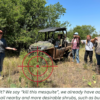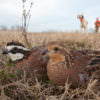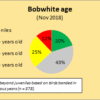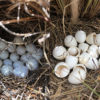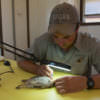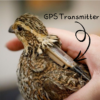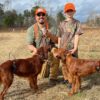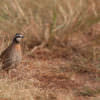
The leaf-spray, or high-volume foliar spray method, is ideal for treating mesquites that are less than 8 feet tall and have multiple stems at ground level. This technique works best in the Summer—beginning when mesquite leaves transition from light green to dark green and continuing through September. It is important to allow any mesquite previously top-killed by fire, cutting, mechanical means, or herbicide to regrow for 2 full growing seasons before applying this method, as new growth must be well-established for effective uptake.
To get started, choose the appropriate sprayer for your property size and terrain. If you have just a few trees to spray, a pump-up garden sprayer may be sufficient. If you plan to treat quite a few mesquites, then you will want to use a backpack sprayer or ATV/UTV mounted sprayers, especially when plants are widely-spaced. Regardless of the equipment, ensure your sprayer has an adjustable-cone nozzle capable of producing a coarse spray that can reach the top of mesquite plants up to 8-foot tall.
When deciding which plants to target, and equally important which to leave, you need to picture what the site will look like in the next 10+ years. If it’s next to your ranch road, will it be scratching your pickup truck or is it in an area where you already have adequate cover for quail and just want to maintain the current shrub density? If so, spray those trees—it is much easier and cheaper to control small mesquites now, than come back in 10+ years with an excavator or dozer. Alternatively, if shrub cover is lacking, leave that (those) tree (s) and let them mature.
We use Sendero™—it does not require an applicator’s license to purchase and is available at most farm stores. The recommended spray mixture includes Sendero herbicide at a 1% concentration in water, along with a nonionic surfactant (e.g., Dawn dishwashing soap) to ensure thorough foliage coverage. Adding spray-marking dye can help identify treated plants and improve efficiency. As a general guide, a 3-gallon tank requires 4 oz. of Sendero, 1 oz. of surfactant, and 1–2 oz. of dye; a 14-gallon tank needs 18 oz. of Sendero, 5 oz. of surfactant, and 5–9 oz. of dye; and a 25-gallon tank would take 32 oz. of Sendero, 8 oz. of surfactant, and 8–16 oz. of dye. Begin spraying once soil temperatures at a 12–18-inch depth reach 75°F+ and foliage is dark green. Thoroughly wet all the mesquite leaves to the point just before runoff or dripping for best results, which may yield 76–100% root kill.
To ensure success, avoid spraying under less-than-ideal conditions. Don’t apply herbicide if mesquite leaves are wet, damaged by hail, insects, or disease, or if recent rains have caused a flush of new, light green growth. Additionally, avoid spraying upwind of desirable vegetation such as trees, shrubs, or crops. Keep in mind that the cost of treatment rises quickly as mesquite density and plant size increase. Mesquites aren’t all bad at an acceptable density (<30% canopy for quail), but they can quickly get out-of-hand. Finally, remember that mesquite control is not a one-time job. Regular monitoring and follow-up treatments are necessary to manage regrowth and keep your property in good condition. – by Kyndall Underwood


